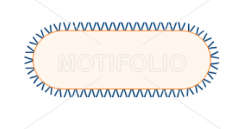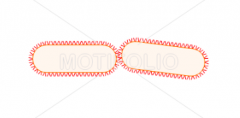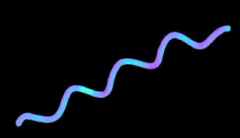![]()
![]()
![]()
Use LEFT and RIGHT arrow keys to navigate between flashcards;
Use UP and DOWN arrow keys to flip the card;
H to show hint;
A reads text to speech;
100 Cards in this Set
- Front
- Back
|
Antigen |
Foreign substance that induced an immune response that interacts with specific antibodies. |
|
|
Antibody |
Special protein that can bind to an antigen on a surface of a pathogen and help destroy it. |
|
|
DNA |
~ Deoxyribonucleic Acid ~ nucleus acid that stores and transmits genetic information from one generation of an organism to the next by coding for the production of a cell's proteins |
|
|
Virus |
Non-cellular particle made up of genetic |
|
|
Bacteriophage |
Virus that invades bacteria and consists of a core of nucleic acid, a capsid, and a tail. |
|
|
Pathogen |
Disease causing microorganism |
|
|
Prophage |
Viral DNA attached to a bacterial chromosome. |
|
|
Retrovirus |
~ Contain RNA as their genetic information ~ their genetic information is copied backwards ~ responsible for some types of cancer in humans and animals |
|
|
Vaccine |
Injection of a weakened or mild form of a pathogen used to produce immunity. |
|
|
Host Cell |
A cell that has been introduced to foreign molecules, viruses or microorganisms. |
|
|
Lymphocyte |
White blood cell that responds to the presence of antigens. |
|
|
Lysogenic Infection |
Process in which viral DNA is inserted into the DNA of a host cell where it can remain for many generations before becoming active. |
|
|
Lytic Infection |
Process in which a host cell is invaded, lysed and destroyed by a virus. |
|
|
Membranous Envelope |
The outer layer of some viruses, which can be derived from the plasma membrane of the host cell. |
|
|
Mucous Membrane |
A membrane that contains mucus glands and lines the body cavities and passages. |
|
|
Nucleic Acid Core |
Part of the nucleic acid where binary fission occurs. The nucleic acid contains the genetic instructions for the activity of a virus. |
|
|
Phagocytic White Blood Cell |
White blood cell that engulfs and destroys microogranisms |
|
|
Protein Capsid |
The protein coat which surrounds the nucleic acid of a virus. |
|
|
Primary Line Of Defense
|
~ Skin: Keeps viruses from penetrating, acts as a barrier ~ Covered Openings: Mucous, hairs, ear wax, and oil- catches viruses |
|
|
Secondary Line Of Defense |
~ White blood cells (Leukocytes) which are found in the blood and are able to engulf and destroy potential infecting agents before they can affect target tissues |
|
|
RNA |
I |
|
|
Tertiary Line Of Defense |
~ Immune Response, Interferon |
|
|
Viral Specificity |
The virus in question is selective in the organism that it infects, the type of cells and the disease that it produces. |
|
|
White Blood Cell |
Blood cell produced in bone marrow that protects the body against invasion by foreign cells or substances. |
|
|
Interferon |
Protein that helps other cells resist viral infection. |
|
|
Characteristics of Viruses |
~ Living Characteristics - Contain DNA or RNA as the nucleic acid, have a protein coat called the capsid, contain small amounts of enzyme material ~ Non-Living Characteristics - Non-cellular, Do no respite, Do not respond to stimuli, Do not grow, Reproduce only within living cells, but not directly from a précis ting form like itself. ~ they are called the "have nots" as they don't possess many of the typical characteristics of cells |
|
|
Characteristics of Viruses |
~ Living Characteristics - Contain DNA or RNA as the nucleic acid, have a protein coat called the capsid, contain small amounts of enzyme material ~ Non-Living Characteristics - Non-cellular, Do no respite, Do not respond to stimuli, Do not grow, Reproduce only within living cells, but not directly from a précis ting form like itself. ~ they are called the "have nots" as they don't possess many of the typical characteristics of cells |
|
|
Parts Of Bacteriophage |
~ Head: Capsid, Nucleic Acid ~ Tail: Collar, Sheath, Tail Fibres, Base Plate, Spike |
|
|
Lyric Cycle |
1. Attachment of virus to the cell wall of a bacterial and injection of nucleic acid into the cell. The protein coat and tail fibres never enter the host cell 2. Replication of vital DNA, and the host cell DNA is destroyed or altered. 3. Protein capsids are formed 4. Assemblage of viruses by putting nucleic acids inside of protein coats 5. Release of new viruses when bacterial cell ruptures and releases up to 300 new bacteriophages |
|
|
Lysogenic Cycle |
1. 'Phage' attaches to host cell and injects DNA 2. Phage DNA forms a circle (plasmid) 3. Phage DNA attaches to bacterial chromosomes and become inactive (prophage) 4. Lysogenic host cell reproduces normally (makes copies of nucleic acid) 5. Prophage may cut loose from host chromosomes 6. New phage DNA + proteins are synthesized and assembled into virus particles 7. The host cell bursts open (lyse) releasing virus particles. |
|
|
How to prevent viruses |
~ Wash your hands, exercise, sleep, proper vitamins, vaccines, quarantine |
|
|
Characteristics of Viruses |
~ Living Characteristics - Contain DNA or RNA as the nucleic acid, have a protein coat called the capsid, contain small amounts of enzyme material ~ Non-Living Characteristics - Non-cellular, Do no respite, Do not respond to stimuli, Do not grow, Reproduce only within living cells, but not directly from a précis ting form like itself. ~ they are called the "have nots" as they don't possess many of the typical characteristics of cells |
|
|
Parts Of Bacteriophage |
~ Head: Capsid, Nucleic Acid ~ Tail: Collar, Sheath, Tail Fibres, Base Plate, Spike |
|
|
Lyric Cycle |
1. Attachment of virus to the cell wall of a bacterial and injection of nucleic acid into the cell. The protein coat and tail fibres never enter the host cell 2. Replication of vital DNA, and the host cell DNA is destroyed or altered. 3. Protein capsids are formed 4. Assemblage of viruses by putting nucleic acids inside of protein coats 5. Release of new viruses when bacterial cell ruptures and releases up to 300 new bacteriophages |
|
|
Lysogenic Cycle |
1. 'Phage' attaches to host cell and injects DNA 2. Phage DNA forms a circle (plasmid) 3. Phage DNA attaches to bacterial chromosomes and become inactive (prophage) 4. Lysogenic host cell reproduces normally (makes copies of nucleic acid) 5. Prophage may cut loose from host chromosomes 6. New phage DNA + proteins are synthesized and assembled into virus particles 7. The host cell bursts open (lyse) releasing virus particles. |
|
|
How to prevent viruses |
~ Wash your hands, exercise, sleep, proper vitamins, vaccines, quarantine |
|
|
Types Of Viruses |
1. Animal Viruses: attack cells in animals 2. Plant Viruses: invade cells of plants 3. Bacterial Viruses: attack bacterial cells |
|
|
Examples Of Viral Diseases |
Smallpox, Polio, Measles, AIDS, Mumps, Influenza, Yellow Fever, Rabies and the common cold |
|
|
RSV |
~ Rous Sarcoma Virus ~ causes cancer in chickens |
|
|
Examples Of Viral Diseases |
Smallpox, Polio, Measles, AIDS, Mumps, Influenza, Yellow Fever, Rabies and the common cold |
|
|
RSV |
~ Rous Sarcoma Virus ~ causes cancer in chickens |
|
|
Edward Jenner |
~ 1796 ~ Interested in small pox ~ Produced the first vaccine |
|
|
Louis Pasteur |
~ Experimented to treat anthrax and rabies ~ believed that a weakened or killed disease that is introduced to the body can produce immunity ~ Experimented on sheep to prove this ~ |
|
|
John Salk |
~ Developed a disease against polio (attacks the nervous system) ~ Used formaldehyde to treat |
|
|
Passive Immunity |
If anybodies produced by other animals against a pathogen are injected into the bloodstream, the produce a passive immunity against the pathogen as long as they remain in circulation. |
|
|
Active Immunity |
The body makes its own antibodies in response to an antigen |
|
|
Prokaryote |
Single celled organism whose cells do not have a nucleus. |
|
|
Bacterium |
One-celled prokaryote; chiefly parasitic or saprophytic. |
|
|
Methanogen |
Bacterium that produces methane gas. |
|
|
Bacillus/Bacilli |
Rod-shaped bacterium |
|
|
Coccus/Cocci |
Spherical bacterium |
|
|
Spirillia |
Spiral-shaped bacterium |
|
|
Phototrophic Autotroph |
Organism that can trap the energy of sunlight and convert it to organic nutrients |
|
|
Chemotropic Autotroph |
Organism that can obtain energy from inorganic molecules |
|
|
Chemotropic Heterotroph |
Organism that can obtain energy by taking in organic molecules and then breaking them down |
|
|
Phototrophic Heterotroph |
Organism that is able to use sunlight for energy but also requires organic compounds for nutrition. |
|
|
Obligate Anaerobe |
Organism that lives only in the absence of oxygen |
|
|
Obligate Aerobe |
Organism that requires a constant supply of oxygen in order to live. |
|
|
Facultative Anaerobe |
Organism that can survive with or without oxygen |
|
|
Fermentation |
Process that enables cells to carry out energy production in the absence of oxygen; breaking down of glucose and release the energy in which organic substances are the final electron acceptors. |
|
|
Nitrogen Fixation |
Process by which nitrogen in the atmosphere is converted into a form that can be used by living things. |
|
|
Resistance |
The failure of a condition to respond to a treatment |
|
|
Binary Fission |
Type of asexual reproduction in which an organism divides to produce two identical daughters |
|
|
Conjugation |
Process in bacteria and protists that involves an exchange of genetic information |
|
|
Endospore |
Type of spore formed when a bacterium produces a thick internal wall that encloses its DNA and a portion of it's cytoplasm |
|
|
Symbiosis |
Close relationship between two species in which at least one species benefits from the other |
|
|
Saprophyte |
Organism that uses the complex molecules of a once-living organism as its source of energy and food |
|
|
Antibiotic |
Drug or natural compound that can attack and destroy certain microorganism |
|
|
Disinfectant |
An agent that disinfects/ destroys microorganisms that may carry a disease |
|
|
Toxin |
Poison |
|
|
Motility |
The ability to move |
|
|
Classification |
The systematic grouping of organisms based on characteristics and relationships. |
|
|
Ecological Roles |
The ecological role that an organism fills in an ecosystem |
|
|
Mutation |
A permanent, inheritable change in the nucleotide sequence. |
|

|
Bacilli/ Bacillus |
|

|
Diplobacillus |
|

|
Streptobacillus |
|

|
Pallisade Arrangement |
|

|
Cocci/ Coccus |
|

|
Diplococcus |
|

|
Streptococcus |
|

|
Staphylococcus |
|

|
Spiral |
|

|
Corkscrew |
|

|
Comma |
|
|
Pathogenic Bacteria |
1. Damage cells and tissues directly 2. Produce toxins or poisons |
|
|
Sexually Transmitted Diseases or Veneral Diseases |
~ Associated with sexually transmitted diseases ~ Two important anaerobic bacteria cause ghorrhea and syphilis ~ Can't develop immunity |
|
|
Gonorrhea |
~ Can cause sterility ~ Most common STD ~ Caused by coccus type bacterium ~ target organs: oviducts and sperm ducts |
|
|
Syphilis |
~ Often goes undiagnosed ~ A spirochete is the bacterial agent ~ First stage is a chancre, second is a rash and third lasts until death and the victim may suffer from tumours throughout the body. |
|
|
Obligate Aerobes: Bacteria |
~ Require oxygen, use cellular respiration ~ limited in their ability to inhabit much of the environment as much of the earth is covered with water and oxygen is not very soluble in water |
|
|
Facultative Anaerobes: Bacteria |
~ Most successful bacteria ~ Use oxygen but can survive if it is not present ~ Use aerobic cellular respiration when oxygen is present but can use fermentation or anaerobic respiration if there is no present oxygen. ~ E. coli |
|
|
Obligate Anaerobes: Bacteria |
~ Cannot use oxygen and are harmed by the presence ~ Use fermentation or anaerobic respiration for energy |
|
|
Aerobic Cellular Respiration: Bacteria |
~ Happens in the mitchondria ~ Most efficient form of energy as it produces the most amount of ATP particles ~ GLUCOSE + OXYGEN > CARBON DIOXIDE + WATER + ENERGY ~ C6H2O6>CO2+H2O+ATP (Energy) |
|
|
Fermentation: Bacteria |
~May produce many end products ~ end product released depends on the enzyme a particular bacteria has ~GLUCOSE>PYRUVATE> either ETHANOL + CARBON DIOXIDE LACTIC ACID ACETIC ACID + CARBON DIOXIDE |
|
|
Anerobic Respiration: Bacteria |
~ GLUCOSE > ETHANOL + CARBON DIOXIDE + ENERGY ~ C6H12O6 > 2 C2H5OH + 2 CO2 + ATP (Energy)
|
|
|
Sterile Technique |
~ To avoid contamination to be sure we only culture the bacteria that we want ~ Use the bunsen burner to sterilize, Open only the life to agar slightly and quickly, Disinfect work area |
|
|
Gram Positive Bacteria |
~ Bacteria have thick walls made up of a protein- sugar complex ~ Takes on a purple colour ~ Cell membrane looks blue ~ Cytoplasm looks brown |
|
|
Gram Negative Bacteria |
~ Have an extra layer of lipid or fat on the outside of the cell wall and appear red ~ protien-sugar complex appear purple ~ cell membrane appear blue ~ cytoplasm appears brown |
|
|
Asexual Reproduction in Bacteria |
~ Binary Fission - DNA is replicated (large circular chromosome is copied), two identical chromosomes align in the centre and then separate and move to opposite ends, the cell divides and two identical daughter cells result. ~Advantage: large number of offspring produced quickly, one individual can ensure survival, adopt to an environment quickly ~ Disadvantages: offspring are genetically identical to the parent and could cause a demise of the whole population. ~ most common form of bacterial reproduction |
|
|
Sexual Reproduction in Bacteria |
~Conjegation ~ Two bacteria cells come in contact and a protein link is formed between two cells, part of the DNA from one cell is copied and passed through the tube, the plasmid gets incorporated into the new cells genome ~ Advantages: genetic diversity, more likely to survive if environment changes ~ Disadvantages: need to find a mate, the number of offspring does not increase as quickly as it does with binary fission. |

